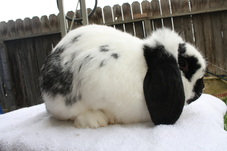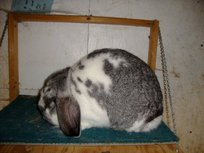The Mini Lop :)
The history behind them:
Mini Lops were first discovered by Bob Herschbach at a German National Rabbit Show in Essen, Germany in 1972. Mini Lops then were known as Klein Widder. A mini lop was made by combining a German Big Lop and a Small Chinchilla rabbit. In 1974, Bob Herschbach decided to bring them to Ventura, California, and they made their big debut. The outcome was that the breed needed to be downsized to a more compact, attractive size. In order to achieve this, Herschbach enlisted the assistance of other breeders by letting them breed more of his Mini Lops. One final touch resulted in changing the breed name from Klein Widders to "Mini Lop" to make it more appealing to the public.In 1980, in Milwaukee, Wisconsin at the National Rabbit Convention, this breed marked its success when it was recognized as an official rabbit breed sanctioned by ARBA.
Their personalities:
Like most rabbits, Mini Lops can come in a variety of personalities. Most of the time, they are very playful, extremely friendly and social. In my experience, they are very smart, and they definitely know who feeds them! These guys sure make a nice pet. But, there are some downsides about them, just like all rabbits. Does, (females) can be very territorial, and could get pretty aggressive if not spayed. Bucks, (males) if not neutered, can spray just like cats. They also like to mate with their toys or other inanimate objects.
A Mini Lop that isn't handled or is neglected, isn't a happy bunny. They tend to stomp around and even bite. But that is just like most rabbits. Mini Lops should be handled all the time, and should be shown the love that they need.
A Mini Lop that isn't handled or is neglected, isn't a happy bunny. They tend to stomp around and even bite. But that is just like most rabbits. Mini Lops should be handled all the time, and should be shown the love that they need.
A.R.B.A
"The ideal Mini Lop is described as being a "basketball with a head". Judges like to see a nice rounded body with thick depth, long thick ears, a wide head and thick bone.
Accepted Varieties and Colors:
The Mini Lop variety comes down to 'Solid' and 'Broken'. A solid variety means that the rabbit is all one color, with no spots. The broken variety means that the rabbit is all white, with a certain color of spots on it. The pattern could come in spotted, or blanket.
Accepted Varieties and Colors:
The Mini Lop variety comes down to 'Solid' and 'Broken'. A solid variety means that the rabbit is all one color, with no spots. The broken variety means that the rabbit is all white, with a certain color of spots on it. The pattern could come in spotted, or blanket.
Spotted: Blanket:
In this breed, most colors are accepted. Some colors include:
Chinchilla, Chestnut Agouti, Lynx, Opal, Black, White, Ruby-Eyed White, Blue-Eyed White, Blue, Chocolate, Seal, Steel, Lilac, Orange, Black, Fawn, Pointed, Tri Color, Smoked Pearl, and Frosted-Pearl.
I am working on a color guide and will show all the different colors.
The Ideal Mini Lop
Body: Massive, thickset, heavily muscled, compact, well balanced. Shoulders broad, well filled with good depth. Hindquarter is broad, deep smooth, rounded, lower hips well filled. Slight taper from the heavier hindquarters to the shoulders. Dewlap permitted on does, should balance with the rest of the rabbit.
Faults: Long, narrow body; flat shoulders or hips; chopped or undercut hindquarters; large dewlap on does.
Head: Strongly developed, sturdy, bold and balanced with the body; not too narrow. Set closely on shoulders with neck as short as possible. Crown boldly arched. Slight curvature of the skull from the base of the crown to the nose.
Faults: Long, narrow head; pointed nose.
Ears/Crown: Ears well placed on top of the head rising from strong basal ridge, lopping vertically on both sides of the head. Ears should hang close to cheeks with ear openings turned toward the head. Outline of ears and crown should resemble a horseshoe. Length and width of ear proportionate and in balance with head and body. Ears well furred, not creased and well rounded at the ends.
Faults: Poor ear carriage; narrow; very thick or very thin ears; folds in the ear; ears turned away from the head; thinly furred ears.
Legs/Feet/Bone: Legs thick, short, straight, with heavy bone. Toenails on broken pattern group may be light or dark; a difference in pigmentation between rear and front is permitted. All front toenails should match and all rear toenails should match.
Faults: Mismatched toenails; fine bone.
Fur: Glossy, lustrous, uniform, medium in length, thick, dense, with good rollback.
Faults: Silky; long/harsh; long/thin; short fur.
Color/Markings: Solid pattern to include all recognized colors within the recognized groups. Broken pattern to include any recognized color within the recognized group in conjunction with white. Broken pattern must exhibit a butterfly pattern on muzzle with wings outlined in white, solid color circle around each eye, solid colored ears are preferred. Color should be evenly distributed in patched or blanketed markings. Broken pattern should have white front feet; elbow patches are desirable. Rear feet may be white, colored, or partially colored.
Faults: Excessive white hairs in solid pattern group; partial nose markings/eye circles in broken pattern group; brokens with highly colored faces so markings are indistinct.
Disqualifications
Body Parts: Mismatched eyes, foreign colored spots in the eye; broken tail or any other broken parts.
Teeth: Malocclusion; broken teeth.
Illness: Any visible illness or life threatening problem.
Color: Absence of head markings on broken pattern; less than 10% color on broken pattern, Excessive white hairs in a colored section.
Other: Abscesses, has Fleas, Mites, or Lice, Rupture of Hernia, Tumor or Abnormal Swelling, Split Penis, Neutered, Over-weight, Illegible tattoo, Tattoo not in the Left Ear, Wrong Sex, Breed, Group, or Variety,
Chinchilla, Chestnut Agouti, Lynx, Opal, Black, White, Ruby-Eyed White, Blue-Eyed White, Blue, Chocolate, Seal, Steel, Lilac, Orange, Black, Fawn, Pointed, Tri Color, Smoked Pearl, and Frosted-Pearl.
I am working on a color guide and will show all the different colors.
The Ideal Mini Lop
Body: Massive, thickset, heavily muscled, compact, well balanced. Shoulders broad, well filled with good depth. Hindquarter is broad, deep smooth, rounded, lower hips well filled. Slight taper from the heavier hindquarters to the shoulders. Dewlap permitted on does, should balance with the rest of the rabbit.
Faults: Long, narrow body; flat shoulders or hips; chopped or undercut hindquarters; large dewlap on does.
Head: Strongly developed, sturdy, bold and balanced with the body; not too narrow. Set closely on shoulders with neck as short as possible. Crown boldly arched. Slight curvature of the skull from the base of the crown to the nose.
Faults: Long, narrow head; pointed nose.
Ears/Crown: Ears well placed on top of the head rising from strong basal ridge, lopping vertically on both sides of the head. Ears should hang close to cheeks with ear openings turned toward the head. Outline of ears and crown should resemble a horseshoe. Length and width of ear proportionate and in balance with head and body. Ears well furred, not creased and well rounded at the ends.
Faults: Poor ear carriage; narrow; very thick or very thin ears; folds in the ear; ears turned away from the head; thinly furred ears.
Legs/Feet/Bone: Legs thick, short, straight, with heavy bone. Toenails on broken pattern group may be light or dark; a difference in pigmentation between rear and front is permitted. All front toenails should match and all rear toenails should match.
Faults: Mismatched toenails; fine bone.
Fur: Glossy, lustrous, uniform, medium in length, thick, dense, with good rollback.
Faults: Silky; long/harsh; long/thin; short fur.
Color/Markings: Solid pattern to include all recognized colors within the recognized groups. Broken pattern to include any recognized color within the recognized group in conjunction with white. Broken pattern must exhibit a butterfly pattern on muzzle with wings outlined in white, solid color circle around each eye, solid colored ears are preferred. Color should be evenly distributed in patched or blanketed markings. Broken pattern should have white front feet; elbow patches are desirable. Rear feet may be white, colored, or partially colored.
Faults: Excessive white hairs in solid pattern group; partial nose markings/eye circles in broken pattern group; brokens with highly colored faces so markings are indistinct.
Disqualifications
Body Parts: Mismatched eyes, foreign colored spots in the eye; broken tail or any other broken parts.
Teeth: Malocclusion; broken teeth.
Illness: Any visible illness or life threatening problem.
Color: Absence of head markings on broken pattern; less than 10% color on broken pattern, Excessive white hairs in a colored section.
Other: Abscesses, has Fleas, Mites, or Lice, Rupture of Hernia, Tumor or Abnormal Swelling, Split Penis, Neutered, Over-weight, Illegible tattoo, Tattoo not in the Left Ear, Wrong Sex, Breed, Group, or Variety,


